Terrington in World War 2 (1939-1945)
Following Britain’s declaration of war on Germany on 3rd September 1939, life in Terrington, as in all communities across the country, was turned upside-down: many of the younger men were conscripted into the armed forces and everyone left behind was subject to rationing. Many of the men in reserved occupations such as agriculture or beyond the age for military service were in the Home Guard and everyone was encouraged to produce more of their own food. Sometimes the war came closer to home as when bombs were dropped nearby or a plane crashed. And there were the Land Army Girls in the village, Italian and German prisoners of war, evacuees from large cities and Ukrainian workers.
Contents of this page:
- Personal memories
- The War comes to Terrington
- The 1939 Register
- Lancaster Bomber crash in November 1943
- German bomber crash near Coneysthorpe
- The Home Guard
- The Women’s Land Army
- Food shortages and the Pig Club
- Others who passed through the village during and after the War
- Casualties
- After the war
Personal memories
Three Terrington residents have recorded their childhood memories of the War. You can listen to the recordings (and read the transcripts) by John Goodwill, born July 1935, Edwin Cooke, born March 1937, and Mrs Doris Goodrick, born April 1917:
- John Goodwill interview in 2001
- John Goodwill interview in 2014
- Edwin Cooke second interview in 2014
- Mrs Goodrick interview in 2002
- Pilot – Flight Officer Russell Alfred Davis RCAF, aged 23, of Toronto, Ontario, Canada.
- Flight Engineer - Sgt Robert Charles Mitchell RAFVR, aged 20, of Glasgow.
- Bomb Aimer – Warrant Officer Alexander Hugh MacDonald RCAF, aged 28, of Bridgeport, Nova Scotia, Canada.
- Air Gunner - Sgt Leonard Wilfred Lehman RCAF, aged 20, of Toronto, Ontario, Canada.
- Air Gunner - Sgt Roy Leslie Green RCAF, aged 19, of Brant, Alberta, Canada.
- Wireless Operator/Air Gunner - Sgt Frederick William Hunt RAFVR, aged 22, of Leicester.
- Flight Sergeant George Thomas Barker
- Flying Officer Arthur James Calvert
- Captain Frank Newton Edwards
- Lance Bombadier Leonard Johnson
- Wing Commander Francis Alfred George Lascelles D.F.C
- Squadron Leader C Raymond (pilot)
- Pilot Officer P F W Gales (observer)
- Flight Sergeant K Rutherford (wireless operator)
- Sergeant L Kelly (bomb aimer)
- Flying Officer A J Calvert (hull gunner)
- Flying Officer R Butler (rear gunner)
- Sergeant H N Pleass (flight engineer)
The War comes to Terrington
John remembers the house shaking and the skies thick with planes as they gathered in preparation for the thousand bomber raids over Germany. And there was always fear as German planes, identifiable by their different engine noise, flew over. There was an air-raid siren on top of the blacksmith’s shop (now The Forge) but we don’t know how often it sounded.
On one occasion after an air raid on York (the Baedeker raids of 1942?) a German bomber jettisoned its unused bomb load on and around Little Terrington. An incendiary bomb set fire to a roof and Edwin remembers his Dad putting it out with a stirrup pump (the fire engine apparently turned up three days later). The next morning the local fields were searched for unexploded bombs or bomb cases and kids were picking them up, carrying them back to the village and leaving them in the policeman’s garden.
There were regular convoys of tanks and military vehicles passing through the village from going to school time throughout the day possibly on their way from a base at Helmsley to manoeuvres on the Wolds. Unguarded, open ammunition huts were dotted around the area ‘right up into the bottom of the village’, and there were searchlights, such as one at Drurys’ farm (North Ings Farm) to light up German planes to pick them out for fighter plane attack.
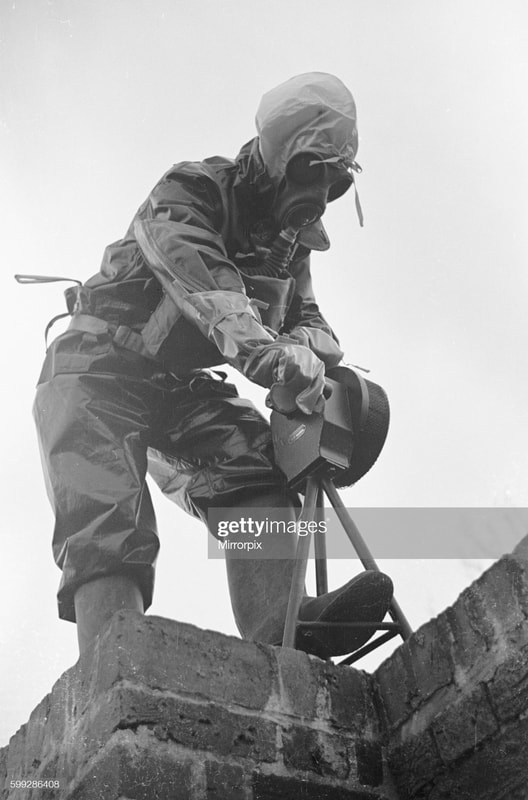
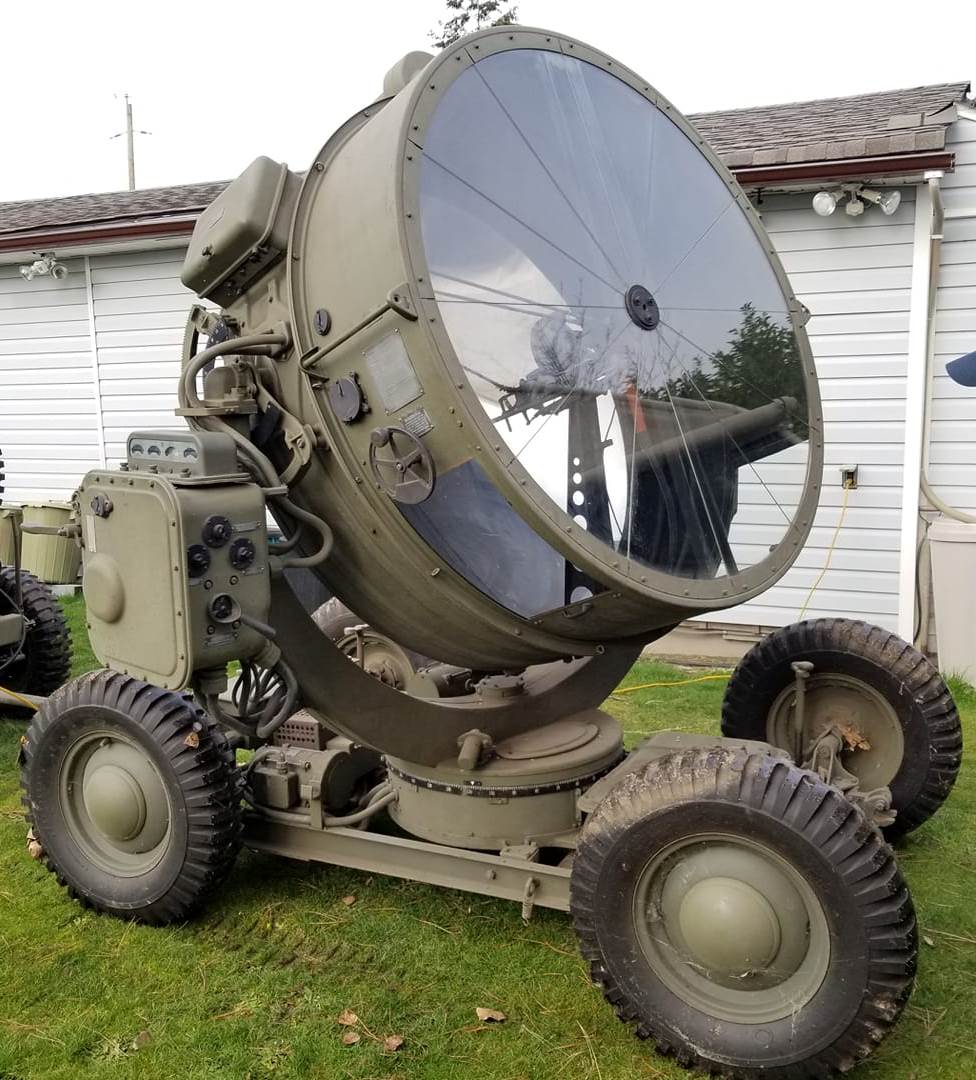
On occasion soldiers seemed to have been billeted in the village, for example the Army took over the Hollies on Main Street and some men were based there. On exercises, soldiers would come in vehicles, park up in the Back Lanes and defend the village against others who would attack, all letting off thunderflashes making a lot of noise. Mrs Goodrick at Ganthorpe Farm remembers a searchlight battery being set up in one of their fields and the soldiers billeted at the farm, and particularly their inept attempts to learn to ride horses before they went out to the Middle East.
Edwin’s and John’s fathers, like many others, were involved in work connected with the War. John’s Dad did work for the MoD at Wombleton airfield and Edwin’s father and others in the village did building work at airfields and at Eden Camp, being built using mainly Italian prisoners.
Opportunities for entertainment may have been restricted during the war. Buses to Malton probably enabled people to go to the cinema and dances. According to Doris Goodrick, in the grounds of Terrington Hall School, in the buildings over the wall from the green lane to the Music Room, there was a big assembly room where dances were held run by Mr and Mrs Robinson who was a teacher at the school. Soldiers came but usually they wanted to go off in their trucks to somewhere to drink.
Three things the War brought to everyone in the country, Terrington included, were gas masks, identity cards and ration books.
There was a real fear of gas attacks on civilians and by September 1939 nearly everybody in the country had been issued with a gas mask, about 38 million masks in total. People were instructed to carry their gas masks at all times in case of attack and fines were to be imposed on anyone caught without their mask. Adults had masks that looked like a pig-snout and the children had special masks, brightly coloured to make them less frightening, and there were versions that babies could be placed inside. Schoolchildren were taught how to put on their masks. For more information see Why Britain issued gas masks in 1939.
Identity cards were issued from September 1939, giving name, sex, date of birth, occupation, address, marital status, and membership of armed services. These had to be carried at all times during the war and until February 1952. Ration books were issued when rationing started in January 1940. It continued until July 1954. More on this later.
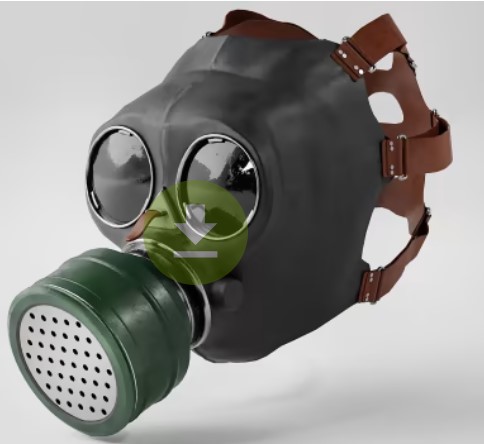
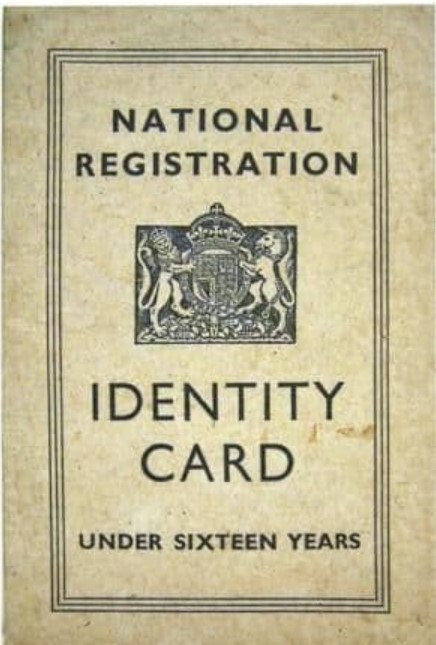
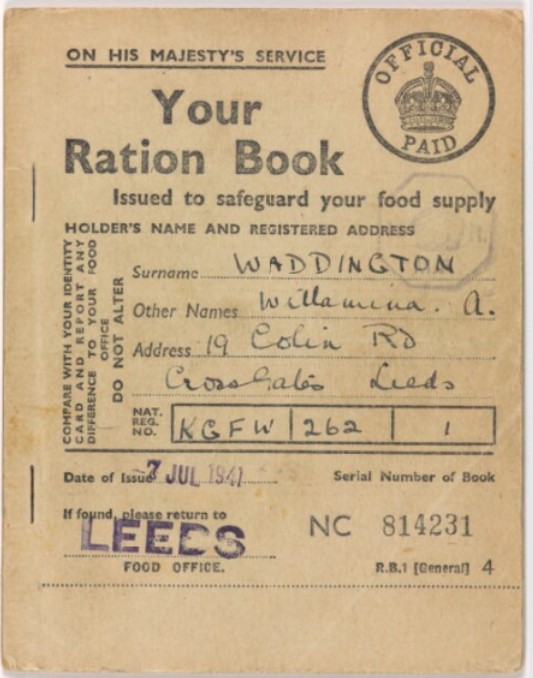
The 1939 Register
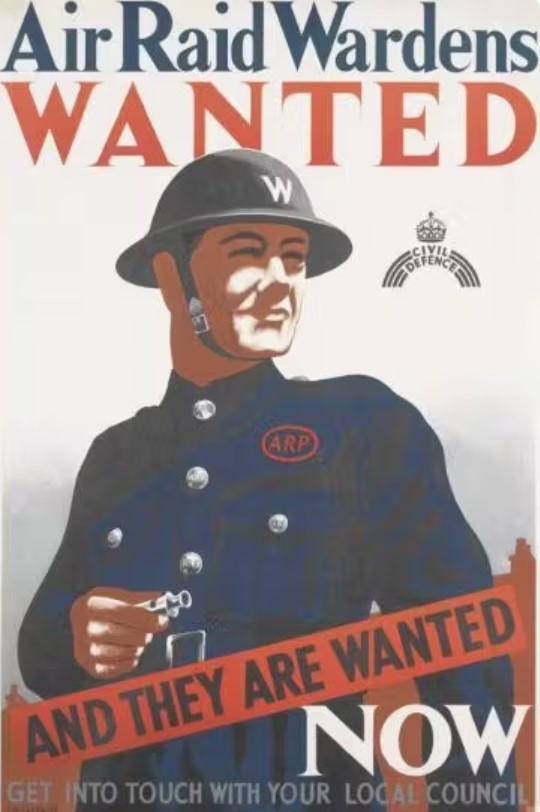
The 1939 Register was taken on 29 September 1939 and included names, dates of birth and occupations of everyone except those in the armed forces. The information was used to produce identity cards, administer conscription and evacuation and, when rationing was introduced in January 1940, to issue ration books. The entries for those born less than 100 years ago and still alive are currently blanked out.
Some of the entries are annotated to indicate that the person performed some war-related duty. In Terrington, we have:
Robert Ellerby, farmer, was an Air Raid Warden. Their main tasks, usually in larger towns and cities, was to try and protect people during air raids by, for example, handing out gas masks and guiding people to shelters. This may not have been too arduous in Terrington.
William Barnby, farmer and Fred Johnson, gardener, were Special Constables. Police service was not a reserved occupation so police ranks were diminished by conscription and special constables were brought in to make up for the deficit.
Francis Wilson, bricklayer, was in the Police War Reserve. As well as the usual duties of a police constable, war reserve constables were responsible for enforcing blackouts, combating black market activity, assisting in evacuations and air raids, and capturing deserting soldiers. We don’t know how busy he was in Terrington.
William Estill, butcher and farmer, and William Goodwill, joiner and carpenter with a petrol station, were in the Auxiliary Fire Service, Malton and Fred Newsome, joiner and cabinet maker, was a member of the British Red Cross.
Residents of The Cliff were active too: Isabel Lascelles was in the Women’s Voluntary Service as was her daughter Ursula* (annotated ‘WVS Billeting’). The WVS was instrumental in the preparations, billeting and ongoing care of millions of children evacuated to the countryside during the war. The other Lascelles daughter, Hermione, was a VAD (Voluntary Aid Detachment) Probationer. The VAD was a voluntary unit of civilians with little formal training who provided nursing care for military personnel.
*Not to be confused with Ursula Lascelles of Sheriff Hutton and Slingsby who travelled to the battlefields of France to support the war effort during World War 1 - see Made in North Yorkshire: Ursula Lascelles.
Alfred Lascelles at The Cliff and the rector’s wife, Kathleen Cockin, are annotated PWC which indicated ‘Post-War Credits’.?
John Withers at Wiganthorpe is annotated as Lieut Comdr Royal Navy?
On the last page of the entries for Terrington in the 1939 Register are a large number of blanked out records seemingly associated with The Cliff (12), The Hall School (5), The Post Office, and two other properties. There is no indication of who these people were but the page may have been added later and may be evacuees.
Lancaster Bomber crash in November 1943
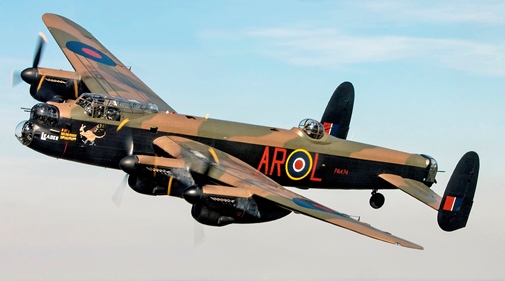
With so much traffic in the air, it is perhaps not surprising that there were a number of crashes locally. One which came down in the parish was a Lancaster DS649 bomber in November 1943.
On Saturday 6th November 1943 the plane took off from East Moor airfield near Sutton-on-the-Forest, one of a series of flights that day as part of a training exercise in flying heavy bombers, having already completed about four take-offs over a period of two hours. The weather was good.
A few minutes into the flight the aircraft struck a tree at Wiganthorpe Lake, damaging the aircraft and propellers, and it crashed at 17.00hrs in a small field just to the north-west of Rose Cottage Farm. The plane was completely wrecked and was burnt out.
People at the top of Terrington village remembered seeing the plane fly over with an engine on fire, so the plane may have been flying so low because the pilot was trying to find somewhere to land. However, the official report on the crash states that all engines were operating correctly before striking the tree.
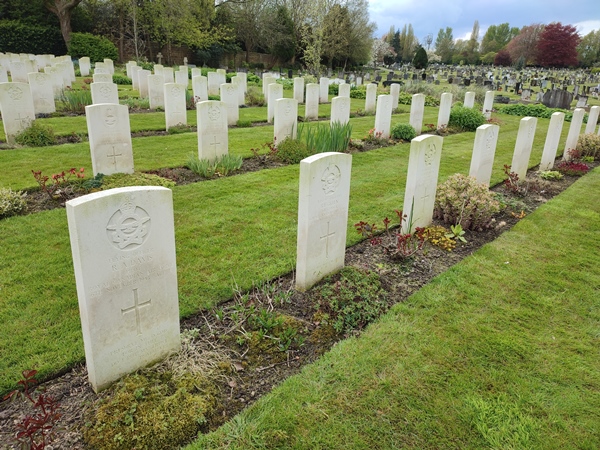
One of the six crew, Sgt Green, was pulled from the wreckage with serious injuries and was rushed to York Military Hospital but either died on the way or shortly after admission.
Four of the crew belonged to the Royal Canadian Air Force (RCAF) and two to the RAF Volunteer Reserve (RAFVR). Five of the men (the four Canadians and one from Scotland) are buried in Stonefall Cemetery, Harrogate, the other one at his home town of Anstey in Leicestershire. The crew were:
This website gives more information about the crash and the crew: Lancaster DS649 near Wiganthorpe, Terrington.
German bomber crash near Coneysthorpe in April 1942
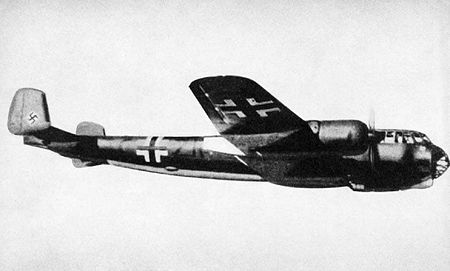
John Goodwill remembers a German Dornier Do 217 plane crashing somewhere between Terrington and Coneysthorpe. In one interview he describes the crash as being ‘at the back of the wood near Peter Goodwill’s farm’ and in the other interview as being ‘in the wood as you go towards, we call it Freer Moor, came to the top of the bank there, there’s some gates into the wood, some big gates, if you go to there and go right through the back.’
The German crew, one of whom was wounded, walked to Coneysthorpe searchlight camp which was near the crossroads, woke the guard and gave themselves up.
The next day John and his Dad went to the site and found that the plane had been on fire and saw a German revolver hanging in a tree.
The crash is presumably the one on the night of 28th/29th April 1942 documented on these websites: Dornier Do217 near Coneysthorpe, Malton and Air Combat Casualties (Luftwaffe & RAF).
The Home Guard

The Home Guard (generally knows as ‘Dad's Army’) was set up in 1940 as Britain's 'last line of defence' against German invasion. In May 1940, Secretary of State for War Anthony Eden made a broadcast calling for men between the ages of 17 and 65 to enrol in a new force, the Local Defence Volunteers (LDV) and within two months nearly 1.5 million men had enrolled. The name of the force was subsequently changed to the ‘Home Guard’.
Members of the Home Guard were usually men above or below the age of conscription, those in reserved occupations, and those unfit or otherwise ineligible for front line military service.
Edwin’s Dad was a member and he remembers that at first they didn’t have rifles, but were then supplied with Lee Enfield .303 rifles and later got Sten guns. They trained at the back of the walled garden of Terrington Hall School where the sports field is now and in the rough area beyond, where they had dugouts. They did guard duty at the top of the village at Mill Hill where there was a tin hut at which they used to stand guard and two trenches across the road.
In the photo of Terrington Home Guard taken in November 1944 there are 32 men, 1 dog and a number of guns. Unfortunately we do not currently have the names of the men. If you can identify any of them please let us know (email: contact@terringtonarchive.net).
This page on the Imperial War Museum website has more information about the Home Guard: The Real 'Dad's Army'.
The Women’s Land Army
With the difficulty of importing food during the war it was necessary to grow more food at home and increase the amount of land in cultivation. The Women's Land Army (WLA), which had been set up during World War 1 and disbanded at the end of the war, was re-formed in June 1939 to help increase agricultural production. Women were initially asked to volunteer to serve in the Land Army and, from December 1941, could also be conscripted into land work. At its peak in 1944, there were more than 80,000 women – often known as 'land girls' – in the WLA.
Much of the information about the Terrington WLA hostel below is taken from the book Yorkshire Women at War by Marrion Jefferies.
Around a dozen land girls were stationed in the hostel in Terrington. This, previously used for prisoners of war, was at the bottom of the village on the right of the Ganthorpe road just below Terrington House and was a long Nissen-type building. It was occupied by the land girls from 1943 to 1946.
The hostel consisted of a Warden’s room, bedrooms for the Warden, Assistant Warden and domestic, a kitchen and scullery, a dormitory and a small sick bay.
The arrival of the girls in Terrington apparently caused quite a stir among all the young men in the village. Otherwise, opinions seem to have been mixed. John Goodwill thought that farmers used to work them very hard and gave them difficult jobs to do while Mrs Goodrick (née Miller) then a young girl at Ganthorpe Farm thought that they were useless and her father didn’t know what to tell them to do, though her brothers thought they were marvellous.
The land girls wore a uniform of long socks, breeches, green jersey, and cowboy-type hat. They did a variety of work such as dairy work, rat catching, and land reclamation.
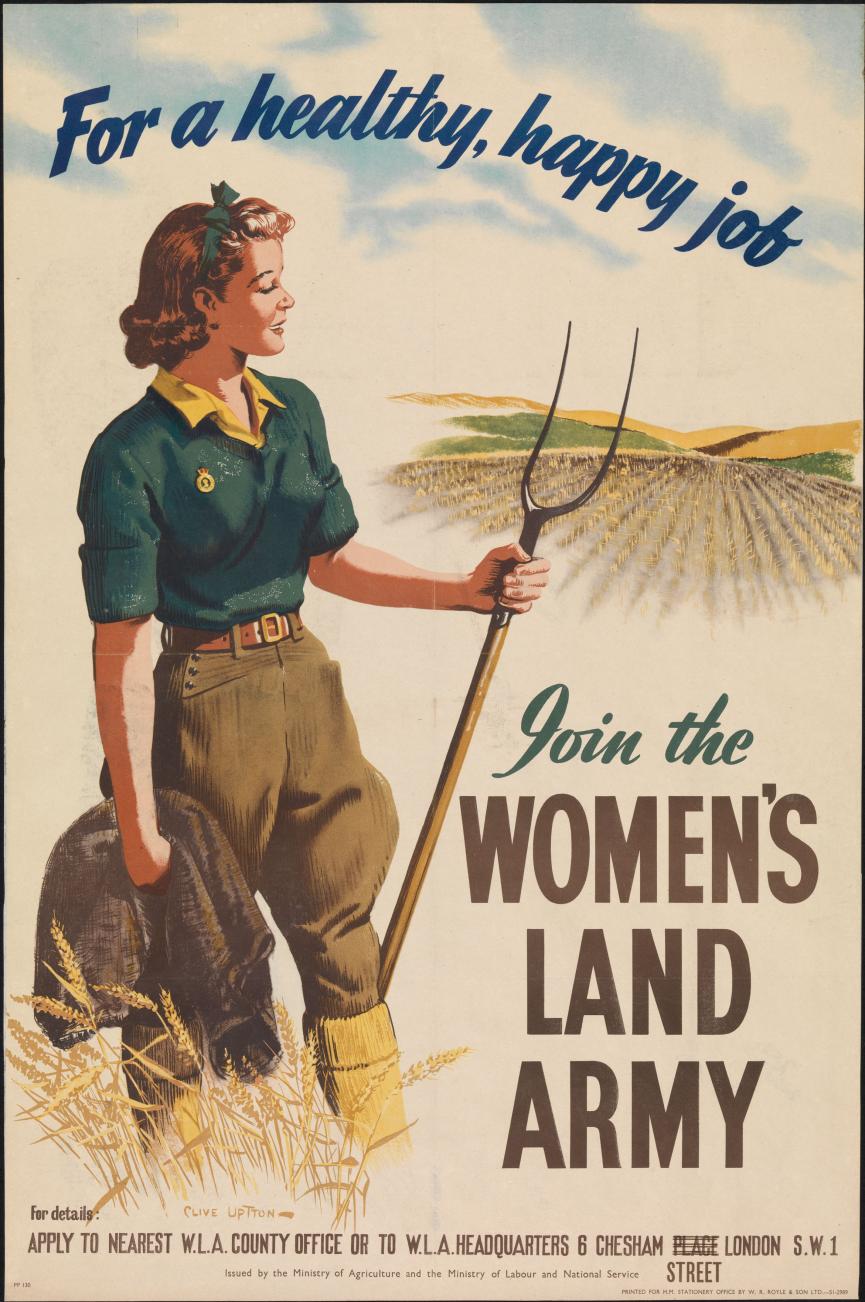
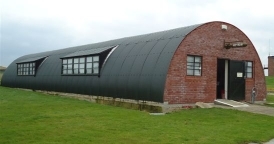
At the Terrington hostel, there seems to have been constant trouble between the Warden and Forewoman as it was unclear who was in charge. The warden complained that the forewoman undermined her authority, was not helpful, was insolent, wouldn’t keep hostel rules and was always late (and came in through the window).
The hostel seems to have been involved in various activities in the village: they held a children’s party and a hotpot supper and organised a bring-and-buy sale which raised £26 for the WLA Benefit Fund. However, it was reported that the hostel came bottom of the WLA hostels competition.
The social life of the land girls was restricted, as there was only one bus a week to Malton (though someone else remarked that there was no bus on Sundays, implying that there were buses on other days). After the invasion of Europe in June 1944 the girls at the hostel seemed depressed and emphasised the isolation of the hostel now there were no troops nearby. Making their own entertainment was suggested but no one could play the piano. The Warden had tried to get ENSA (Entertainments National Service Association) films, but Terrington was too far from their usual route.
One girl asked for a transfer as she had quarrelled with her boyfriend who lived at the farm she worked on. ‘She was a good worker but inclined to use bad language.’ On the other hand, another of the girls, Louie Butterworth, who had been a rag sorter in Ossett before the war, married a local lad, Cyril Hartas, in 1949 and lived in the village for most of the remainder of her life. She died in 2016 aged 98 and is buried in Terrington Cemetery.
On one occasion the Ministry of Works closed the hostel for three days because of bugs.
After the land girls had left the hostel it was occupied by displaced persons.
The following webpages contain more information about the Women's Land Army: What was the Women's Land Army and Women's Land Army & Timber Corps.
Food shortages and the Pig Club
Food production in Britain was lower at the start of World War 2 than at the end of World War 1 with 60% of food being imported. The advent of war drastically reduced food imports and available shipping needed to be employed in the war effort. Hence the need to vastly increase food production.
The Women’s Land Army was one part this effort. War Agricultural Executive Committees (War Ags) were set up in each county and could decide which crops should be planted in which fields, so as to best increase the production of foodstuffs in their areas. Much more land was put under the plough and in 1940 farming was declared a reserved occupation so that any farmworker who wanted to join the armed forces had to be replaced before they could leave. The unemployed and conscientious objectors were sent to work on farms, as were prisoners of war.
At the start of the war there were still 600,000 working horses on farms and only 56,000 tractors. Many of the horses were soon replaced by tractors which were faster, more reliable and more powerful. The War Ags helped farmers to purchase tractors and within a year the number of tractors had doubled.
The Ministry of Agriculture and Fisheries carried out a huge educational effort, using leaflets and short films shown in cinemas before the main feature as part of the Dig for Victory campaign to encourage people to grow more of their own food in their gardens and on public land, with advice on growing vegetables for year-round production, storing, bottling and canning fruit and vegetables, salting, jam, jelly, pickle and chutney making, making a compost heap, making Bordeaux mixture to control blight in potatoes, dealing with pests, how to sow seeds, how to dig, saving seed, pruning, and using National Growmore Fertiliser.
Blackcurrant cultivation was encouraged as other fruits rich in vitamin C such as oranges became very difficult to obtain. The Vitamin Welfare Scheme was started in December 1941 and provided blackcurrant syrup and cod liver oil free to children under the age of two (though orange juice was provided under the US Lend-Lease programme from April 1942).
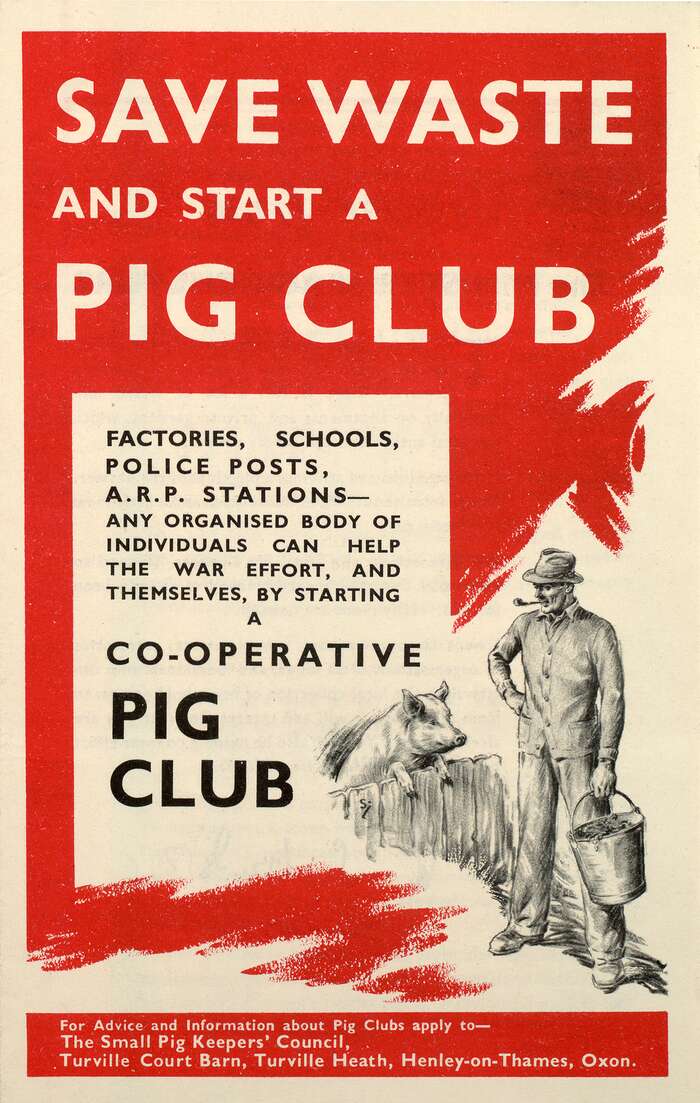

To make up for the shortage of meat people were encouraged to keep pigs. According to John Goodwill, Orchard Cottage, at the junction of Mowthorpe Lane and South Back Lane West (previously a Primitive Methodist Chapel) became the home for a Pig Club during World War 2, when the government encouraged people to keep a pig and created the Small Pig Keepers' Council (SPKC) to give advice and set rules on how groups and individuals should raise pigs. With the bulk purchase of pig food, a lot of householders kept pigs. The meat was salted in pantries, and salt is still in the walls of some houses in Terrington to this day.
Household food waste was used to feed the pigs and the members of the club cleaned the sties, and ultimately shared in the meat produced. Half of the meat from the pigs raised was supposed to be handed over to the Ministry of Food though, apparently, this did not always happen and hams were sold on the black market.
Edwin remembers that his family and their next-door neighbours at Little Terrington had piggeries in the garden with two pigs each and had a permit to kill them themselves, and they cut them up and salted them down for their own ham and bacon.
Despite all these measures to increase food production, many basic items of food were in short supply and it was necessary to ration them. Rationing was introduced in 1940 and continued until 1954. The Ministry of Food ran a campaign to help the public make the best use of their rations and to avoid waste.
People had to nominate a shop for the purchase of meat, eggs, fats, cheese, bacon and sugar and only a certain quantity of each could be bought. For other items, such as tinned goods, dried fruit, cereals, biscuits, and clothes, a points system operated: you were given a certain number of points each week and you handed over points when you purchased items. The number of points allocated changed according to availability and consumer demand.
Supplements including milk, concentrated orange juice or blackcurrant syrup for vitamin C and cod liver oil for vitamin D were given to pregnant women, children and the elderly. Some manual labourers, such as miners and Land Girls, received extra rations.
We don’t know to what extent rationing affected Terrington as eggs, milk and butter would have been produced locally, and gardens could have supplied all the vegetables needed. Pork was to be had thanks to the Pig Club and local farmers may have seen things right for people they knew. There were houses in the village with orchards still at that time so apples could be had too. Sugar and tea would have been on ration, while chocolate and the very occasional orange would have been real luxuries. Bananas were no longer to be had.
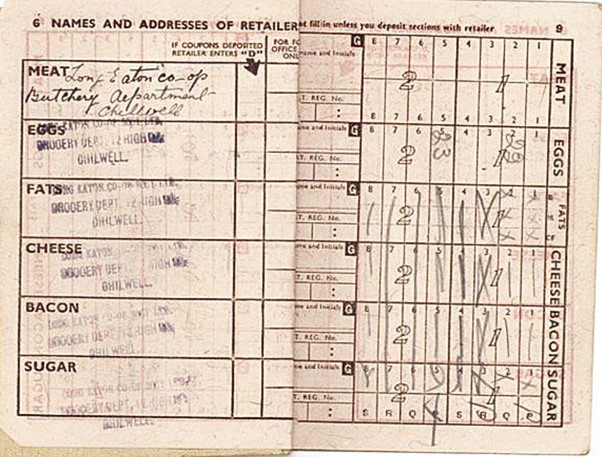
For more information about rationing see What You Need To Know About Rationing In The Second World War.
For a useful timeline of rationing see Second World War Rationing.
Others who passed through the village during and after the War
The Nissen hut occupied by the Women’s Land Army seems to have housed German prisoners of war before the WLA and there seem also to have been prisoners, German and Italian, locally later in the war. They worked in agriculture and building.
Edwin remembers that the prisoners had an armed guard taking them to work on farms or wherever on a coach or bus and keeping guard over them but that around the end of the war the guard was relaxed or non-existent, so the prisoners were free to wander about the village, even sledging on Cliffe Hill. To top it all the lads of the village were allowed to watch war films with the German prisoners of war.
Some of the prisoners were reluctant to go back to the Russian-occupied zone and they were here for quite a while after war ended. After that there were Ukrainian displaced persons until well into the 1950s when the hostel closed. Between 1946 and 1950, with the Soviet Union occupying Ukraine, around 35,000 Ukrainians came to the United Kingdom as part of the European Volunteer Workers scheme, intended to address labour shortages by providing jobs for displaced people.
Evacuated children from Teesside and Hull were in the village for a short time, billeted into houses but the local lads didn’t mix with them. They were probably from the rougher areas of the cities and were considered ‘a queer lot’ and apparently used to go round raiding people’s dustbins.
For more information see The Evacuated Children Of The Second World War and When the war was over: European refugees after 1945.
Casualties
Five men with Terrington connections lost their lives on active service in the War and are commemorated on the World War 2 memorial in the Churchyard. Three of them were in the RAF and two in the Army. In 2014, six residents of Terrington researched the stories of the men associated with Terrington killed in both World War 1 and World War 2 and the results were published in a book by the Ryedale Family History Group.


Below is some information about the five men and the actions in which they died or were lost:
Flight Sergeant George Thomas Barker
Background
George Thomas (Tom) Barker was born at Riseborough, between Pickering and Kirkbymoorside, in 1912, the eldest of 5 children of George Robert and Clara. In the 1911 census George Robert, aged 23, was working on his father’s farm, Hall Farm, Riseborough, and in early 1912 he married Clara Holliday in Pickering.
In the 1921 census George Robert and Clara were living with George Robert’s parents at The Grange, Old Byland, with their 5 children: George Thomas, aged 8, Mary, aged 6, Robert, aged 4, all born at Riseborough, Fred, aged 2, born at Kirkbymoorside, and Marjorie, aged 3 months, born at Old Byland.
At some time the family moved to Terrington, having spent time at Skewsby Manor. Tom joined the RAF in 1929 aged 16 or 17 which may have been before his family moved to Terrington. He trained as a pilot and before the war served in India and Afghanistan.
In 1939 George Robert was a farmer in Terrington at Flat Top Farm with Clara who died early in 1940.
In early 1940 Tom married Vi Biddiscombe at Andover, Hampshire.
Killed in action
Tom was in 150 Squadron which was part of the RAF Advanced Air Striking Force (AASF), based near Rheims. At the time of Tom’s death the squadron was equipped with the Fairey Battle 1 single-engine light bomber and was involved in action around the Meuse bridge at Sedan in north-eastern France, near the Belgian border, which had been taken by the Germans and the Allies were trying to prevent them from breaking out and moving further into France.
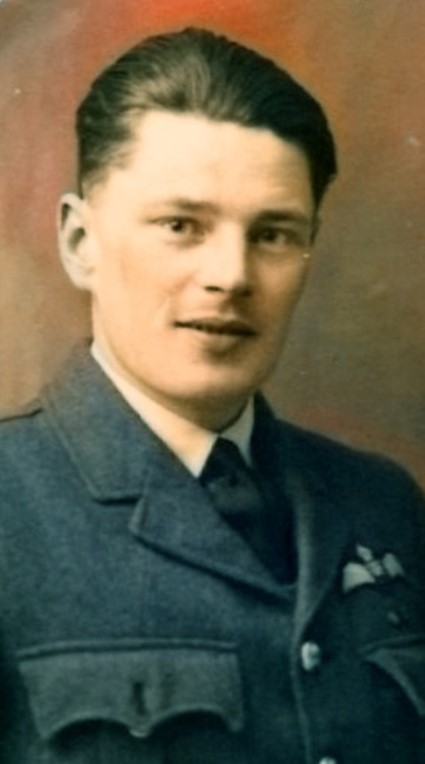
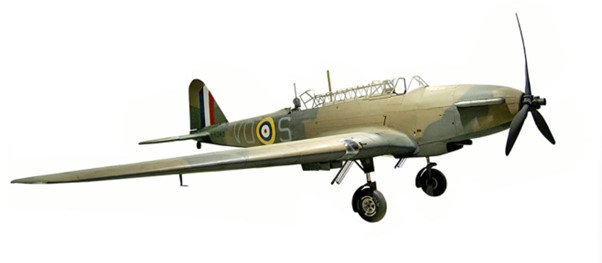
At 15:24 on 14 May 1940 four planes took off from Ecury-sur-Coole on a day raid to bomb pontoon bridges over the river Meuse at Sedan. None of the four aircraft returned. Tom’s plane was shot down at Bois de l'Arbre near Raucourt-et-Flaba in the Ardennes, 6 miles south of the target. Flight Sgt. Barker, the pilot, and Sgt Williams, the observer, were killed, while wireless operator/air gunner Summerson was badly injured but evaded capture and was picked up by the French.
Afterwards ...
Tom, who died at the age of 27, is buried in Choloy War Cemetery, 40km west of Nancy in north-eastern France which was created for the re-burial of casualties recovered from a number of isolated sites, communal cemeteries, and small churchyards in the area where permanent maintenance of the graves was not possible.
The heavy losses of the Fairy Battle plane led to the decision that it was not adequate for such operations and, on 20 May, less than a week later, the squadron was evacuated back to the UK and in October was re-equipped.
Tom's widow, Vi married again in 1950 to George McMillan in Andover.
Tom’s brothers Robert, born 1916, who later married the widow of Leonard Johnson (see below) and Fred, born 1918, became farmers at Terrington.
Tom’s father George Robert Barker died on 11th January 1973, aged 84. He, and mother Clara who died on 26th January 1940, aged 51, are buried in Terrington Cemetery.
Flying Officer Arthur James Calvert
Background
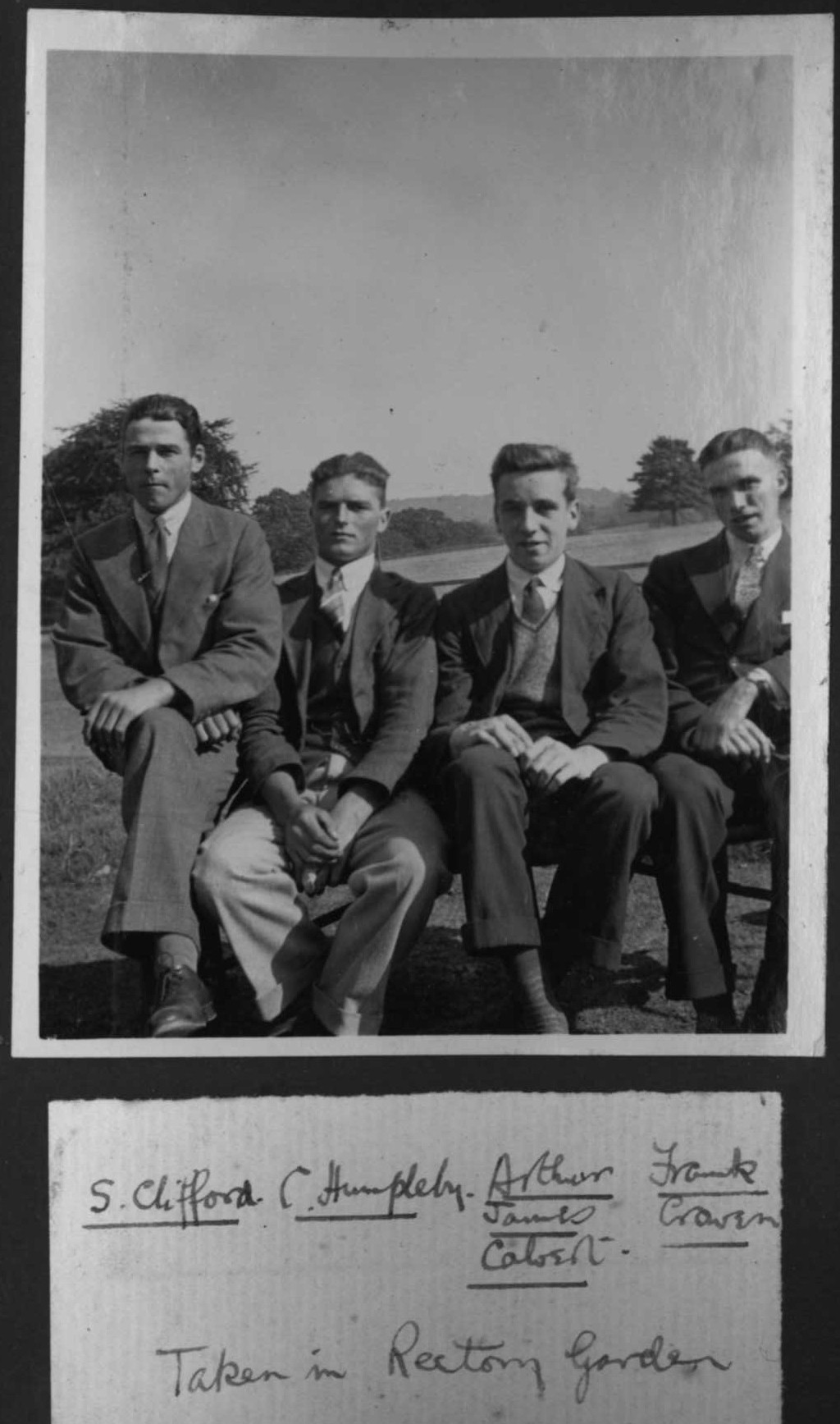
Arthur was born in Terrington on 29th February 1916 and baptised on 26th March 1916 by rector James Wimbush. He was the son of George Calvert, carrier, and Frances née Lacy, daughter of tailor John Lacy. George and Frances had been next-door neighbours in Terrington and married in 1913.
George died on 22 June 1916, soon after Arthur was born. Arthur started school in Terrington at the age of 4 and left aged 11 having reached standard IV.
In the 1921 census Frances Calvert, aged 44, was living in Terrington with her widowed mother, Ann Lacy, daughter Winifred M Calvert, aged 7 years and 6 months, and son Arthur, aged 5 years and 4 months.
Arthur and 3 friends featured in one of rector James Wimbush’s 1933 photographs of parishioners. Arthur’s mother and sister, Fanny and Winnie Calvert, the latter a folk dancer, were also photographed.
On 1st January 1941, Arthur married Margaret Aitken Adam in Pittenweem, Fife.
Lost in action
At the time of his death on 23rd or 24th September 1942, Arthur was a Flying Officer in 218 Squadron of the RAF. His plane, a Short Stirling 1, took off from Downham Market, Norfolk at 23:25 for a raid on Vegesack with Arthur as Air Gunner. There were submarine and shipbuilding yards at Vegesack, on the east bank of the Weser River three miles northwest of Bremen. The plane was shot down by a night fighter into the North Sea about 40 Miles off Nordeney in the Frisian Islands.
The Operation Record shows the following details:
Weather. Occasional rain.
Visibility. 6-12 miles except in rain.
F.L. 5,000 feet.
Training. The usual pre-operational training took place. 11 aircraft flew 10 hours.
Operations.10 crews were detailed and briefed for operations tonight. They were:- A. S/L. Raymond … [This was the plane in which Arthur was air gunner. The pilots of the other 9 aircraft are listed.]
Operational summary. 5 crews detailed for Gardening. Planted their vegetables successfully from 600 feet in allotted positions. 5 crews were detailed to attack Vegesack. 1 attacked, 1 brought bombs back, 1 jettisoned, 1 attacked last resort Oldenburg and nothing was heard after take-off of Aircraft ‘A’ S/L. Raymond. Low cloud made it impossible to bomb visually at primary. The last resort aircraft bombed visually and saw his bombs drop on S.E. portion of the town. 36420 lbs. of bombs were dropped during this operation.
'Gardening' referred to laying mines ('vegetables') in sea-lanes.
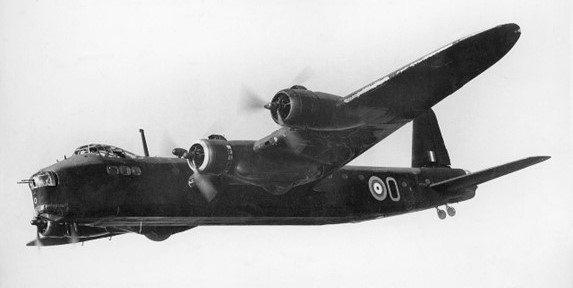
The crew were:
Afterwards ...
Arthur died at the age of 26. He has no known grave and is commemorated on the Runnymede Memorial.
His residence at the time of his death was given as Pittenweem, Fife and Arthur J Calvert is listed in the War Memorial in Pittenweem.
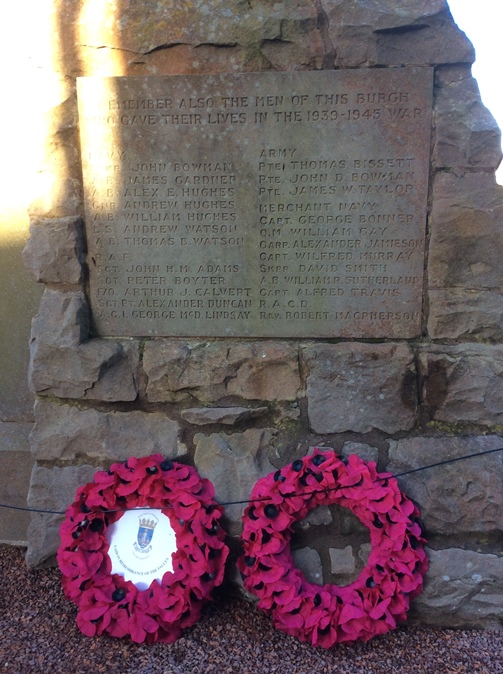
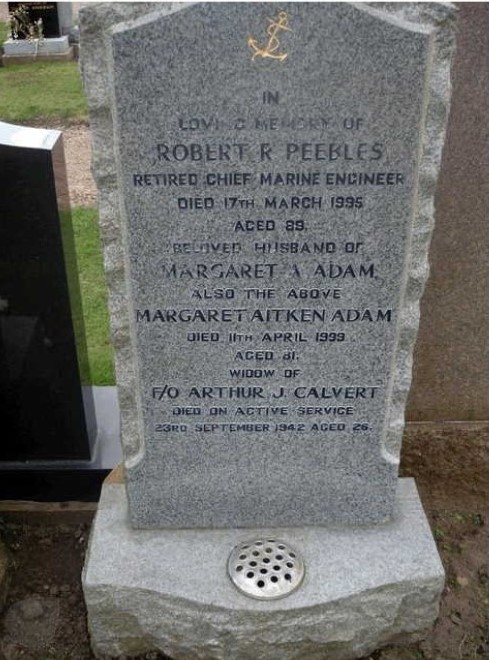
Arthur's son, Michael Arnold Calvert, was born in Pittenweem in 1942.
In 1953 Arthur's widow Margaret married Robert Robertson Peebles in Anstruther and Kilrenny, Fife.
Arthur’s mother, Frances Calvert, died in Terrington in October 1963 aged 86 and is buried in Terrington Cemetery.
Robert Robertson Peebles died in 1995. His widow Margaret Aitken Adam died in Pittenween in 1999 aged 81. Her memorial reads:
In loving memory of Robert R. Peebles Retired Chief Marine Engineer died 17th March 1995 Aged 89
Beloved Husband of Margaret A Adam
Also the above Margaret Aitken Adam died 11th April 1999 Aged 81
Widow of F/O Arthur J. Calvert died on Active Service 23rd September 1942 Aged 26.
Captain Frank Newton Edwards
Background
Frank was born in West Wickham, Bromley, Kent in 1919 to Thomas Newton Edwards and Agnes née Woodifield who had been married in Lambeth in 1918.
In the 1921 census Thomas Newton, Wholesale Lace Warehouseman, aged 46, Agnes, aged 41, and Frank Newton, aged 1 year and 10 months, are still living in West Wickham.
By the time of the 1939 Register, Thomas Newton and Agnes were living in Lytham St Anne’s where Thomas Newton was retired and an air raid warden. Thomas Newton’s brother, Frank Edwards, Traveller in Cattle Foods, and widowed sister, Caroline Davis, Poultry Farmer, were at The Lodge in Terrington.
Killed in action
Frank Newton Edwards was a Captain in the 6th Battalion, The Green Howards. He was killed on 26th October 1942 at El Alamein, during the North Africa Campaign. Allied forces were attempting to prevent German and Italian forces moving eastwards from Libya towards the Suez Canal. The Allies had retreated to a north-south line at El Alamein, chosen because the Qattara Depression to the south formed a barrier to German tanks. The circumstances of Frank’s death are described on the webpage Flames of War. His unit advanced on enemy machine gun placements with bayonets fixed to their rifles across a minefield behind an artillery barrage. Frank was killed leading an assault.
Afterwards ...
Frank is buried in Al Alamein War Cemetery.
According to the National Probate Calendar (Index of Wills and Administrations), at the time of his death, Frank’s address was The Lodge, Terrington.
Frank’s father, Thomas Newton Edwards seems to have settled in Terrington and became a church warden. A Mr T Edwards was present in September 1948 at the inauguration of the World War 2 memorial in Terrington Churchyard and presumably this was Frank’s father (and not the Terrington rector, also Thomas Edwards). He died on 11 October 1948 at The Lodge, aged 73 and is buried in Terrington Cemetery. Agnes had died in March 1947 in Islington.
Lance Bombadier Leonard Johnson
Background
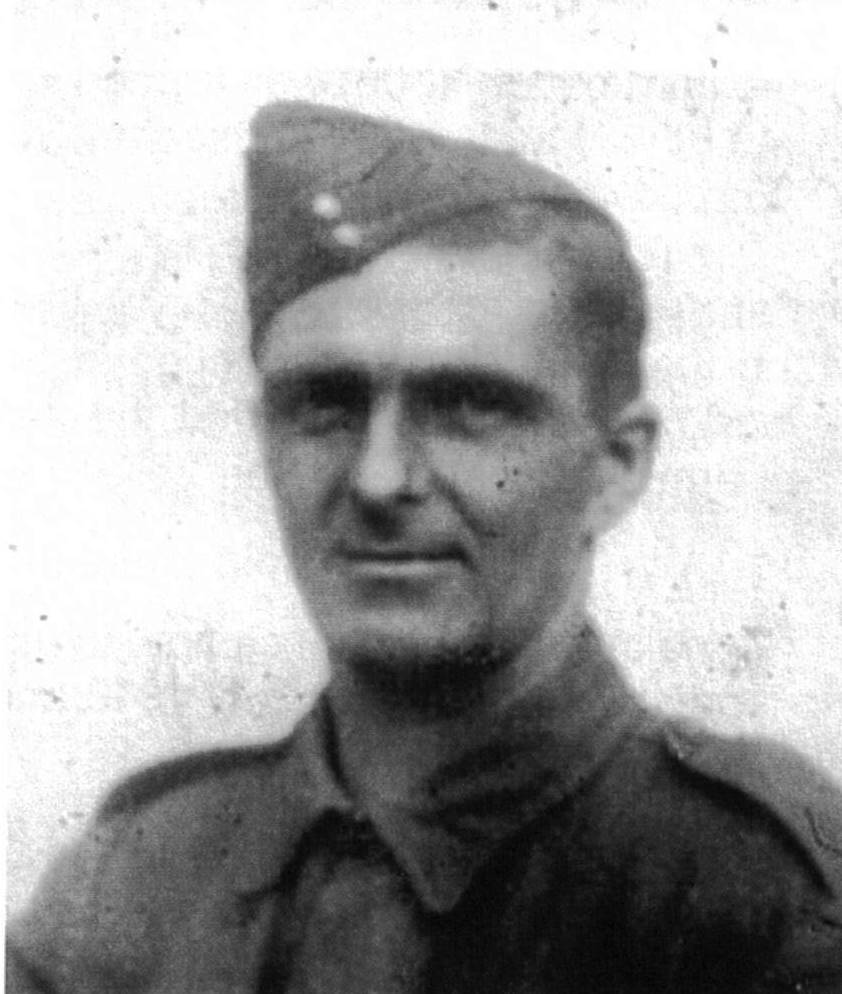
Leonard was born in 1910 to John (Jack) and Evelyn Johnson at Westow.
In the 1911 census, John, aged 31, a game-keeper and (Emma) Evelyn née Bielby, aged 27, had been married for 5 years and had 3 children: Sophia aged 5, Lilian aged 2, and Leonard added 11 months. They also had a boarder, 23 year-old Albert Bielby, presumably Evelyn’s brother, who was a groom.
In the 1921 census, the family had moved across the Pennines to Over Wyresdale where John was gamekeeper for the Earl of Sefton. There were 3 sons and 3 daughters, including Leonard aged 11, though Sophia was no longer at home. From the places of birth of the children the family had moved from Westow to Tarbock and then Kirkby, both in Lancashire, before arriving at Over Wyresdale.
The family must have felt the pull of God’s Own Country from those foreign parts, because in early 1938 Leonard married Edith Mona Wood from Flatt Top Terrington and a son John Richard was born on 16th June 1938.
In the 1939 Register, Leonard is an estate rabbit catcher and farm worker at Wiganthorpe, Edith has unpaid domestic duties, and John R is the only child. Parents John, still a gamekeeper, and Emma Evelyn, meanwhile, had moved to Nidderdale.
Killed in action
Leonard served in the 142nd Field Regiment of the Royal Artillery (The Royal Devon Yeomanry). Leonard’s regiment was active in the Italian Campaign from the invasion of Sicily on 9th July 1943 and the invasion of the mainland on 3 September 1943, the invasion coinciding with an armistice made with the Italians who then re-entered the war on the Allied side.
Following the fall of Rome to the Allies in June 1944, the German retreat became more organised and successive stands were made on a series of defensive positions known as the Trasimene, Arezzo, Arno and Gothic Lines, in an attempt to halt the northward advance of the Allies. The Gothic Line comprised a chain of defended positions stretching across the Italian peninsula, from north of Pisa on the west coast to near Rimini on the east.
The Allies formulated a plan, Operation Olive, to break through the Gothic Line defences by pushing north toward Rimini and from there on to the plains of Northern Italy. The Battle of Rimini began on 13th September 1944 and Rimini was taken by the Allies on 21st September.
Leonard was killed on 16th September 1944.
Afterwards ...
Leonard was 34 years old. He is buried in the Gradara War Cemetery, 30km south-east of Rimini, near the Adriatic coast. The site for the cemetery was chosen in November 1944 and it contains the graves of casualties incurred during the advance from Ancona to Rimini and in the heavy fighting around Rimini. It contains 1,191 Commonwealth burials and one Belgian war grave.
Leonard’s widow, Edith Mona married Robert (Bob) Barker of Flatt top Farm in 1959 and her son with Leonard, John Richard, later took over the farm.
Edith Mona died on 8th January 1993, aged 80, and John Richard Johnson, Leonard and Edith's son, died in 2008, aged 70. Bob died on 25th March 2014, aged 97. They are all buried in Terrington Cemetery.
Wing Commander Francis Alfred George Lascelles D.F.C

Background
Francis (known as Frank) was the son of Sir Alfred Lascelles and Isabel Carteret Thynne. Sir Alfred, the grandson of the 3rd Earl of Harewood, was born at Harewood and became a barrister. After working in Cyprus for 4 years, he was appointed Attorney General of Ceylon (now Sri Lanka) in 1902 and was Chief Justice of Ceylon from 1911 to 1914.
Alfred and Isabel married in 1911 and Francis was born in Colombo in 1912.
In 1914 or 1915 Sir Alfred and Lady Lascelles bought The Cliff in Terrington following the death of Mary Egerton.
In the 1921 census, Sir Alfred and Lady Isabel were at The Cliff with son Francis Alfred George aged 8 years and 10 months, 3 younger daughters, and 7 servants: a governess, parlour maid, housemaid, kitchen maid, cook, nurse, and nurse maid.
The Cliff was Frank’s family home but it is probable that he would have been sent away to school. It is not known whether he was living in Terrington up to his service in the RAF. The 1933 Wimbush photographs feature Sir Alfred and Lady Lascelles but none of their children.
Sir Alfred was Chairman of the Terrington School Managers (presumably of the Village School), a trustee of the Terrington Charities, and a Malton Magistrate for 24 years until his retirement as Bench Chair in 1938.
Killed in action
Frank was squadron leader in 82 Squadron of the RAF which was active in the Coastal Service and operation Channel Stop, attacking enemy shipping and protecting allied shipping.
On the day of his death, Frank’s plane, a Bristol Blenheim IV, took off from Bodney at 10:32 on 26 August 1941.
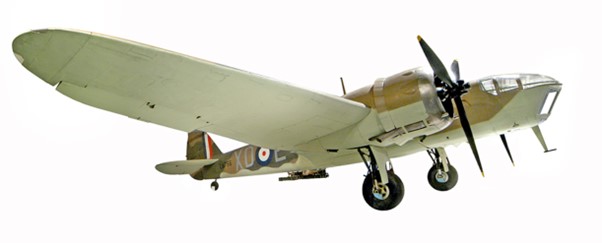
The Operations Record states:
Weather – Fair. Orders were received that six aircraft were to make a low-level attack on Heligoland. Two aircraft through engine trouble were not able to continue with the formation and returned to base. [Another record states that the second aircraft lost touch with the formation and returned.] Of the other four no news has since been received.
The plane was shot down by a Messerschmitt Bf109 fighter over the target during a low-level attack on submarine pens at Heligoland.
The crew were: Wing Commander Lascelles, Sergeant Ordway, and Flight Sergeant Weir.
Afterwards ...
Frank died at the age of 29. He was posthumously promoted to the rank of Wing Commander and was awarded the DFC (Distinguished Flying Cross). He is buried at Sage War Cemetery near Grossenkneten, Lower Saxony, Germany.
Sir Alfred Lascelles died in Terrington in 1952 aged 94 and is buried in Terrington Cemetery. The Cliff subsequently became the Village Hall. Lady Isabel died in Cirencester in 1965 aged 89.
After the war
On 6th June 1944 (D-Day) the Allied invasion of Normandy began though it was not until 7th May 1945 that the formal act of military surrender was signed by Germany, ending the war in Europe. On 8th May 1945 - known as Victory in Europe Day (V-E Day) - celebrations erupted around the world and continued well into the night with parties, singing and dancing, bonfires and fireworks.
That was still not quite the end, though, and Victory over Japan Day (V-J DAY) on 15 August marks the surrender of the Japanese forces, which effectively ended the Second World War.
As part of the end-of-war celebrations in Terrington, Mr Clementson, Headmaster of Terrington Hall School, organised a bonfire party at the school. John Goodwill remembered that the RAF had some 15-seater rubber dinghies housed at the boathouse near the current café on Castle Howard Lake which they used to do training for rescue work. John, ever resourceful, and his mates biked to Castle Howard, got into the boathouse, and found Verey lights (distress signals), green and red, which they packed into their pockets. On the way back, at Shaw Wood, there was a shed containing flash bombs, used in mock battles, which they added to their collection. All this booty made a wonderful show at the Bonfire Night.
Normal life no doubt returned slowly after the war for most people. Soldiers will have returned from Europe, Ukrainians were still at the hostel for some time, and rationing continued until 1954.
The World War 2 War memorial was erected in 1948 by public subscription to the five men with Terrington associations who lost their lives in the war. The unveiling service was attended by Sir Alfred and Lady Lascelles and Thomas Newton Edwards (see the Terrington War Memorials page).
